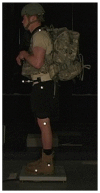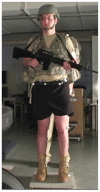The Effect of Military Load Carriage on Postural Sway, Forward Trunk Lean, and Pelvic Girdle Motion
- PMID: 28479946
- PMCID: PMC5213736
- DOI: 10.70252/MNVP1390
The Effect of Military Load Carriage on Postural Sway, Forward Trunk Lean, and Pelvic Girdle Motion
Abstract
Musculoskeletal injuries are a common occurrence in military service members. It is believed that the load carried by the service member impedes stability and alters back and pelvis kinematics, increasing their susceptibility to musculoskeletal injuries, specifically in the lower extremities. The purpose of this study was to examine the effects of two different loads on postural sway, forward trunk lean, and pelvic girdle motion in United States Army Cadets. Twenty male Army Reserve Officers' Training Corps Cadets participated in this study. Each participant performed the Modified Clinical Testing of Sensory Interaction (mCTSIB) Protocol and the Unilateral Stance (ULS) Protocol under three different rucksack load conditions (unloaded, 16.0 kg, and 20.5 kg loads). Mean postural sway velocity was recorded along with 2-D kinematics of the trunk in the sagittal plane and the pelvis in the frontal and sagittal planes. External loads of 16.0 kg (p < 0.001) and 20.5 kg (p ≤ 0.003) significantly increased mean sway velocity by 16% to 52% depending on stance and visual condition, but did not produce significant changes in trunk and pelvic kinematics.
Keywords: ARMY; Spine; balance; motion analysis; stability.
Figures
Similar articles
-
The association of fear of movement and postural sway in people with low back pain.Front Psychol. 2022 Nov 18;13:1006034. doi: 10.3389/fpsyg.2022.1006034. eCollection 2022. Front Psychol. 2022. PMID: 36467232 Free PMC article.
-
Movement Quality Assessment of Army Reserve Officers' Training Corps Cadets: A Report of Validity and Normative Data.Mil Med. 2024 Nov 5;189(11-12):e2537-e2544. doi: 10.1093/milmed/usae266. Mil Med. 2024. PMID: 38829677
-
The effects of incremental changes in rucksack load on lower extremity joint Kinetic patterns during ruck marching.Ergonomics. 2021 Aug;64(8):971-982. doi: 10.1080/00140139.2021.1893391. Epub 2021 Mar 10. Ergonomics. 2021. PMID: 33688792
-
Effects of carried weight on random motion and traditional measures of postural sway.Appl Ergon. 2006 Sep;37(5):607-14. doi: 10.1016/j.apergo.2005.10.002. Epub 2005 Dec 13. Appl Ergon. 2006. PMID: 16356467
-
Biomechanics of Load Carriage--Historical Perspectives and Recent Insights.J Strength Cond Res. 2015 Nov;29 Suppl 11:S129-33. doi: 10.1519/JSC.0000000000001031. J Strength Cond Res. 2015. PMID: 26506175 Review.
Cited by
-
Effects of Law Enforcement Load Carriage Systems on Muscle Activity and Coordination during Walking: An Exploratory Study.Sensors (Basel). 2023 Apr 17;23(8):4052. doi: 10.3390/s23084052. Sensors (Basel). 2023. PMID: 37112391 Free PMC article.
-
Effects of Load Carriage on Postural Sway and Relative Ground Reaction Forces in Special Police Officers: A Cross-Sectional Study.Int J Environ Res Public Health. 2022 Dec 13;19(24):16710. doi: 10.3390/ijerph192416710. Int J Environ Res Public Health. 2022. PMID: 36554591 Free PMC article.
-
Military-Type Workload and Footwear Alter Lower Extremity Muscle Activity During Unilateral Static Balance: Implications for Tactical Athletic Footwear Design.Sports (Basel). 2020 Apr 28;8(5):58. doi: 10.3390/sports8050058. Sports (Basel). 2020. PMID: 32354166 Free PMC article.
-
The Influence of Body Armor on Balance and Movement Quality.Int J Exerc Sci. 2018 Jun 1;11(1):648-656. doi: 10.70252/GKGZ3954. eCollection 2018. Int J Exerc Sci. 2018. PMID: 29997722 Free PMC article.
References
-
- 21-18 F. Field Manual: Foot Marches. Washington, DC: Department of the Army; 1990.
-
- Al-Khabbaz YS, Shimada T, Hasegawa M. The effect of backpack heaviness on trunk-lower extremity muscle activities and trunk posture. Gait Posture. 2008;28(2):297–302. - PubMed
-
- Angin S, Ilcin N, Yesilyaprak SS, Simsek IE. Prediction of postural sway velocity by foot posture index, foot size and plantar pressure values in unilateral stance. Eklem hastaliklari ve cerrahisi = Joint diseases & related surgery. 2013;24(3):144–8. - PubMed
-
- Attwells RL, Birrell SA, Hooper RH, Mansfield NJ. Influence of carrying heavy loads on soldiers’ posture, movements and gait. Ergonomics. 2006;49(14):1527–37. - PubMed
-
- Benoit DL, Ramsey DK, Lamontagne M, Xu L, Wretenberg P, Renström P. Effect of skin movement artifact on knee kinematics during gait and cutting motions measured in vivo. Gait Posture. 2006;24(2):152–64. - PubMed
LinkOut - more resources
Full Text Sources



